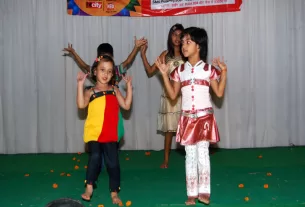In Hinduism, the Goddess Durga, also known as Shakti or Devi, is the protective mother of the universe. She is worshipped as “Shakti” by the Shakts, as a protector of all that is good and harmonious in the world. In Sanskrit, Durga means “the Inaccessible (a fort)” or “a place that is difficult to overrun,” an apt metaphor for this deity’s protective, militant nature. Devi Durga is sometimes referred to as Durgatinashini, which literally translates into “the one who eliminates sufferings.”
According to legend, Durga was created for the slaying of the buffalo demon Mahishasura by Brahma, Vishnu, Mahesh (Shiv), and other Deities, who were otherwise powerless to overcome him. Embodying their collective Shakti (energy), she is both derivative from the male divinities and the true source of their inner power. She is also greater than any of them. Born fully grown and beautiful, Durga presents a fierce menacing form to her enemies. She is usually depicted riding a Lion and with 8 or 10 arms, each holding the special weapon of one of the Gods, who gave them to her for her battle against the Buffalo Demon. Durga Puja, held annually in her honour, is one of the great festivals of India.
Her Many Forms :
In Hinduism, the major Gods and Goddesses have multiple incarnations. Durga is no different; among her many avatars are Parvati, Uma, Kali, Bhagvati, Bhavani, Ambika, Lalita, Gauri and so on.
Durga’s Appearance :
When Devi Durga appears as herself, she manifests in one of nine appellations or forms: Skandamata, Kushmanda, Shailaputri, Kaalratri, Brahmacharini, Maha Gauri, Katyayani, Chandraghanta, and Siddhidatri. Collectively known as the Navadurga, each of these deities have their own special methods of Puja methods, Mantra and day/time.
Befitting her role as mother protector, Durga is multi-limbed so that she may always be ready to battle evil from any direction. In most depictions, she has between eight (Ashtbhuja) and 18 arms and holds a symbolic object in each hand.
Like her consort Shiva, the goddess Durga is also referred to as Triyambake (the three-eyed Goddess). Her left eye represents Desire, symbolized by the Moon; her right eye represents Action, symbolized by the Sun; and her middle eye stands for Knowledge, symbolized by Fire.




